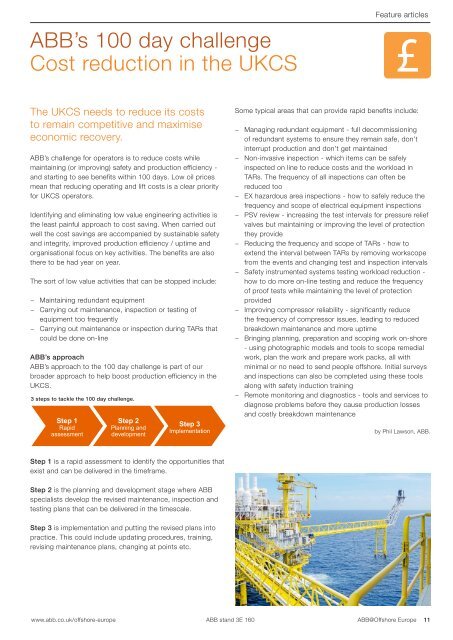ABB@Offshore Europe
R5kDf
R5kDf
- No tags were found...
You also want an ePaper? Increase the reach of your titles
YUMPU automatically turns print PDFs into web optimized ePapers that Google loves.
ABB’s 100 day challengeCost reduction in the UKCSFeature articlesThe UKCS needs to reduce its coststo remain competitive and maximiseeconomic recovery.ABB’s challenge for operators is to reduce costs whilemaintaining (or improving) safety and production efficiency -and starting to see benefits within 100 days. Low oil pricesmean that reducing operating and lift costs is a clear priorityfor UKCS operators.Identifying and eliminating low value engineering activities isthe least painful approach to cost saving. When carried outwell the cost savings are accompanied by sustainable safetyand integrity, improved production efficiency / uptime andorganisational focus on key activities. The benefits are alsothere to be had year on year.The sort of low value activities that can be stopped include:−−Maintaining redundant equipment−−Carrying out maintenance, inspection or testing ofequipment too frequently−−Carrying out maintenance or inspection during TARs thatcould be done on-lineABB’s approachABB’s approach to the 100 day challenge is part of ourbroader approach to help boost production efficiency in theUKCS.3 steps to tackle the 100 day challenge.Step 1RapidassessmentStep 2Planning anddevelopmentStep 3ImplementationSome typical areas that can provide rapid benefits include:−−−−−−−−−−Managing redundant equipment - full decommissioningof redundant systems to ensure they remain safe, don’tinterrupt production and don’t get maintainedNon-invasive inspection - which items can be safelyinspected on line to reduce costs and the workload inTARs. The frequency of all inspections can often bereduced tooEX hazardous area inspections - how to safely reduce thefrequency and scope of electrical equipment inspectionsPSV review - increasing the test intervals for pressure reliefvalves but maintaining or improving the level of protectionthey provideReducing the frequency and scope of TARs - how toextend the interval between TARs by removing workscopefrom the events and changing test and inspection intervals−−Safety instrumented systems testing workload reduction -how to do more on-line testing and reduce the frequencyof proof tests while maintaining the level of protectionprovided−−Improving compressor reliability - significantly reducethe frequency of compressor issues, leading to reducedbreakdown maintenance and more uptime−−−−Bringing planning, preparation and scoping work on-shore- using photographic models and tools to scope remedialwork, plan the work and prepare work packs, all withminimal or no need to send people offshore. Initial surveysand inspections can also be completed using these toolsalong with safety induction trainingRemote monitoring and diagnostics - tools and services todiagnose problems before they cause production lossesand costly breakdown maintenanceby Phil Lawson, ABB.Step 1 is a rapid assessment to identify the opportunities thatexist and can be delivered in the timeframe.Step 2 is the planning and development stage where ABBspecialists develop the revised maintenance, inspection andtesting plans that can be delivered in the timescale.Step 3 is implementation and putting the revised plans intopractice. This could include updating procedures, training,revising maintenance plans, changing at points etc.www.abb.co.uk/offshore-europeABB stand 3E 160<strong>ABB@Offshore</strong> <strong>Europe</strong>11



